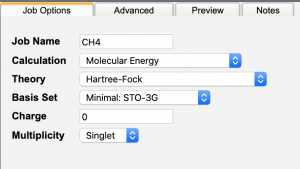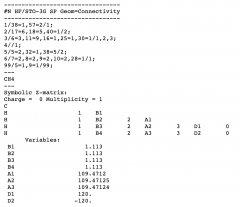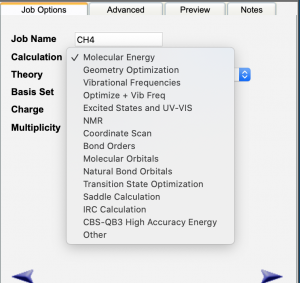Difference between revisions of "Comp Chem 02"
(→Theory) |
|||
| (16 intermediate revisions by the same user not shown) | |||
| Line 1: | Line 1: | ||
| − | (4/ | + | (4/16/20, bes) |
Previous pages: | Previous pages: | ||
| Line 76: | Line 76: | ||
'''''Below are the most common levels of theory''''' | '''''Below are the most common levels of theory''''' | ||
====Hartree-Fock==== | ====Hartree-Fock==== | ||
| − | The details of this | + | :The details of this level of theory is described in Sec 15.3. (not required reading now) |
| + | |||
| + | :The Hartree-Fock (HF) theory makes 3 approximations: | ||
| + | ::# Nuclei are stationary relative to the motion of the electrons; this is the ''Born-Oppenheimer Approximation.'' | ||
| + | ::# Electrons act independently of each other; this is the ''Hartree-Fock Approximation.'' <-- this is totally not correct, but makes the calculations very doable. | ||
| + | ::# The solution (ie. wavefunctions or orbitals) to the multi-electron schrodinger equation should be similar to the atomic solutions (wavefunctions or orbitals). So atomic orbitals (AO) form the basis for the multi-electron/molecular orbitals (MO); The MOs are a linear combination of atomic orbitals (LCAO); this approximation has no name. | ||
| + | |||
| + | ====B3LYP==== | ||
| + | :This is a form of "density functional theory." This is outlined in section 15.6.3. (not required reading now) | ||
| + | |||
| + | :This theory make significantly less approximation than HF, but as a result it can take much longer to complete these calculations. | ||
| + | |||
| + | ====Moller-Plesset==== | ||
| + | :This is outlined in section 15.6.2. (not required reading now) | ||
| + | |||
| + | ====Configuration Interaction==== | ||
| + | :This is outlined in section 15.6.1 (not required reading now) | ||
| + | |||
| + | :These are not a great improvement over HF and hence are not listed in the WebMO drop down menu | ||
===Basis Set=== | ===Basis Set=== | ||
| + | :The basis set is related to how the wavefunctions are approximated. This is covered in Section 15.7 (not required reading now). Since the wavefunctions are the "solutions," these wavefunctions contain variables (ie. parameters) that can be altered to fit the molecular systems being explored. | ||
| + | |||
| + | :[[File:Screen Shot 2020-04-16 at 7.51.30 AM.png|400px]] | ||
| + | |||
| + | ====Minimal==== | ||
| + | :This basis set, ''Minimal: STO-3G'' is the simplest representation of the wavefunction. The term STO is an abbreviation for "Slater Type Orbital" and the "3G" is an abbreviation for 3 Gaussians, an STO-3G is a Slater type orbital described using three Gaussian functions. There is also an STO-XG (ie STO-6G), but it does not really generate better results; STO-3G is the most commonly used minimal basis set. | ||
| + | |||
| + | ====Basic==== | ||
| + | :This basis set, ''Basic: 3-21G'' is an improvement over STO-3G and is referred to as a "split-valance" basis set. This differs from STO-3G in that the valence electrons are treated differently than the core electrons...3-21G means the core electrons are approximated by 3 Gaussian functions and the valence electrons are "split" into "inner" valence electrons represented by 2 Gaussians and "outer" valence electrons represented by 1 Gaussian. | ||
| + | |||
| + | ====Routine==== | ||
| + | :This basis set, ''Routine: 6-31G(d)'' is an improvement over 3-21G and is also a "split-valence" basis set with the addition of "diffuse functions" (d-orbitals). The additional of a d-orbital allows for the wavefunctions to be "polarized" or asymmetric. 6-31G(d) means the core electrons are approximated by 6 Gaussian functions and the valence electrons are "split" into "inner" valence electrons represented by 3 Gaussians and "outer" valence electrons represented by 1 Gaussian, with the addition of d-orbitals to allow for asymmetry in the solution. | ||
| + | |||
| + | ====Accurate==== | ||
| + | :This basis set, ''Accurate: 6-311+G(2d,p)'' is an improvement over 6-31G(d) and is also a "split-valence" basis set with additional diffuse functions. 6-311+G(2d,p) means the core electrons are approximated by 6 Gaussian functions and the valence electrons are "split" into 3 separate types of valence electrons represented by 3, 1, and 1 Gaussians, with the addition of 2 d-orbitals and 1 p-orbibal to allow for even greater asymmetry in the solution. | ||
| + | |||
| + | ====Other==== | ||
| + | :As with the "Theory" dropdown menu, not all basis sets are listed in the dropdown menu. Other basis sets can be input, like EPR-II or EPR-III for doing radical calculations. | ||
===Charge/Multiplicity=== | ===Charge/Multiplicity=== | ||
| + | :When using the graphical interface to "draw" the molecular structure, you are showing connectivity between the atoms. If electrons are added, the negative charge increases and the multiplicity also changes. So "charge and multiplicity accounts for electron configuration not well described by the molecular structure. Multiplicty is calculated as: | ||
| + | :::2S+1 where S is the number of unpaired electrons *1/2. For example, if an system has 2 unpaired electrons (like O<sub>2</sub> gas), the multiplicity is 2*(2*1/2) +1 = 3 or triplet; radicals with one unpaired electron has a multiplicity of 2 or doublet. | ||
| + | |||
| + | Please do (now or email me with when you will have it done) the following exercise: | ||
| + | |||
| + | [[WebMO_Basis_set_1| Exercise 4: Exploring Effect of Theory and Basis Sets]] | ||
Latest revision as of 22:09, 25 April 2020
(4/16/20, bes)
Previous pages:
In the previous discussion you were taught how to submit a WebMO/Gaussian job and analyze results related to measuring of bond length and angles, viewing molecular orbitals, and determining the rotation barrier energy about a carbon-carbon bond. We will continue to use WebMO/Gaussian to develop chemistry insights, but first we must discuss further the nature of the calculations that were done in the previous exercises.
Review
WebMo is an excellent tool (graphical interface) to build an input file for the Gaussian engine. WebMO assisted in the construction of the input file; you are familiar with the figure on the left where you select your job/calculation parameters. The middle figure is generated if you choose to "preview" the job parameters, and the figure to the right shows how Gaussian interpreted the WebMO input file. The figure on the right is an excerpt from the "Raw output" "Actions" item accessed through the "View Job" window.

|
Job Options
As shown above, the user must specify certain job options. Each of these options will be discussed briefly.
Calculation
Molecular Energy
- This option calculates the energy, or "single-point (SP) energy" of the structure "as drawn" in the Build Molecule window. After building a molecule, structures are "cleaned up" and default bond lengths and bond angles are used. This calculation can be used to see how the energy changes as bond lengths/angles are changes. Overall, this is not a very useful type of calculation.
Geometry Optimization
- This option requests that a geometry optimization (OPT) be performed. The geometry (all bond length and bond angles) will be adjusted until the lowest energy configuration is found. There are multiple ways to adjust the geometry and there are multiple ways to evaluate when the lowest energy has been found, more on this later. This is probably the most used calculation option.
Vibrational Frequencies
- This option computes force constants and the resulting vibrational frequencies (FREQ).
Optimize + Vib Freq
- Because it is often necessary to optimize geometry (OPT) prior to doing a vibrational frequency (FREQ) analysis, an option exists to do these operations in series.
Excited States and UV-Vis
- For now, the name says a lot...calculates UV-Vis spectrum.
NMR
- Calculates the expected NMR spectrum. This does not work real well unless you use a very high level of theory. Please note that there are many NMR "simulation" packages...these use empirical (experimental) data to make an educated guess at the NMR spectrum. The math used to simulate is different than the math (QM) used in computational approaches.
Coordinate Scan
- A coordinate scan carries out a set of calculations on a molecule that differ in a single "coordinate," like bond angle. In the previous Exercise 3 - Study of Rotation Barrier Energy about Carbon-Carbon Bonds we performed a coordinate scan to show how the energy is dependent on the "torsion angle" of the central C-C bond.
Bond Orders
- skip for now
Molecular Orbitals
- Everybody knows about atomic orbitals, 1s, 2s, 2p, 3s, 3p, 3d, 4s, 4p, 4d, 4f, --> 7f, and we have even plotted the hydrogen atom atomic orbitals using Mathematica (or at least shown in the text). Again, i hate to be the bearer of bad news, but when a second electron is added to the picture, ie. helium, these well loved atomic orbitals (solutions to the Schrodinger Equation) are no longer valid. When two elements come together to form a bond, the resulting molecule orbitals (solutions to the Schrodinger Equation) look nothing like the atomic orbitals. We did do an introductory molecular orbital calculation in Lab 1, titled Exercise 2 - Study of the Molecular Orbitals in Ethene, CH2CH2.
Natural Bond Orders
- skip for now
Transition State Optimization
- skip for now
Saddle Calculation
- skip for now
IRC Calculation
- skip for now
CBS-QB3 High Accuracy Energy
- skip for now
Other
- WebMO has the above "common" calculation types hard-wired into the drop down menus. Gaussian can do many other, less common calculations and if you wish to do these you need to find the "keyword" to enter here.
Theory
The term "theory" make reference to how the Schrodinger equation is written/interpreted. As we will find out in Chapter 10: Multi-electron systems, we can easily write out the full Schrodinger equation (there are many terms and it might take a few minutes to write out), but as noted, this cannot be solved. So this is where we make approximations. Each "level of theory" has a different set of assumptions. The more approximations made (ie, the lower the level of theory) the less time it takes to complete the calculation. When less approximations are made (ie. higher level of theory) the longer the calulations take to complete.
Below are the most common levels of theory
Hartree-Fock
- The details of this level of theory is described in Sec 15.3. (not required reading now)
- The Hartree-Fock (HF) theory makes 3 approximations:
- Nuclei are stationary relative to the motion of the electrons; this is the Born-Oppenheimer Approximation.
- Electrons act independently of each other; this is the Hartree-Fock Approximation. <-- this is totally not correct, but makes the calculations very doable.
- The solution (ie. wavefunctions or orbitals) to the multi-electron schrodinger equation should be similar to the atomic solutions (wavefunctions or orbitals). So atomic orbitals (AO) form the basis for the multi-electron/molecular orbitals (MO); The MOs are a linear combination of atomic orbitals (LCAO); this approximation has no name.
B3LYP
- This is a form of "density functional theory." This is outlined in section 15.6.3. (not required reading now)
- This theory make significantly less approximation than HF, but as a result it can take much longer to complete these calculations.
Moller-Plesset
- This is outlined in section 15.6.2. (not required reading now)
Configuration Interaction
- This is outlined in section 15.6.1 (not required reading now)
- These are not a great improvement over HF and hence are not listed in the WebMO drop down menu
Basis Set
- The basis set is related to how the wavefunctions are approximated. This is covered in Section 15.7 (not required reading now). Since the wavefunctions are the "solutions," these wavefunctions contain variables (ie. parameters) that can be altered to fit the molecular systems being explored.
Minimal
- This basis set, Minimal: STO-3G is the simplest representation of the wavefunction. The term STO is an abbreviation for "Slater Type Orbital" and the "3G" is an abbreviation for 3 Gaussians, an STO-3G is a Slater type orbital described using three Gaussian functions. There is also an STO-XG (ie STO-6G), but it does not really generate better results; STO-3G is the most commonly used minimal basis set.
Basic
- This basis set, Basic: 3-21G is an improvement over STO-3G and is referred to as a "split-valance" basis set. This differs from STO-3G in that the valence electrons are treated differently than the core electrons...3-21G means the core electrons are approximated by 3 Gaussian functions and the valence electrons are "split" into "inner" valence electrons represented by 2 Gaussians and "outer" valence electrons represented by 1 Gaussian.
Routine
- This basis set, Routine: 6-31G(d) is an improvement over 3-21G and is also a "split-valence" basis set with the addition of "diffuse functions" (d-orbitals). The additional of a d-orbital allows for the wavefunctions to be "polarized" or asymmetric. 6-31G(d) means the core electrons are approximated by 6 Gaussian functions and the valence electrons are "split" into "inner" valence electrons represented by 3 Gaussians and "outer" valence electrons represented by 1 Gaussian, with the addition of d-orbitals to allow for asymmetry in the solution.
Accurate
- This basis set, Accurate: 6-311+G(2d,p) is an improvement over 6-31G(d) and is also a "split-valence" basis set with additional diffuse functions. 6-311+G(2d,p) means the core electrons are approximated by 6 Gaussian functions and the valence electrons are "split" into 3 separate types of valence electrons represented by 3, 1, and 1 Gaussians, with the addition of 2 d-orbitals and 1 p-orbibal to allow for even greater asymmetry in the solution.
Other
- As with the "Theory" dropdown menu, not all basis sets are listed in the dropdown menu. Other basis sets can be input, like EPR-II or EPR-III for doing radical calculations.
Charge/Multiplicity
- When using the graphical interface to "draw" the molecular structure, you are showing connectivity between the atoms. If electrons are added, the negative charge increases and the multiplicity also changes. So "charge and multiplicity accounts for electron configuration not well described by the molecular structure. Multiplicty is calculated as:
- 2S+1 where S is the number of unpaired electrons *1/2. For example, if an system has 2 unpaired electrons (like O2 gas), the multiplicity is 2*(2*1/2) +1 = 3 or triplet; radicals with one unpaired electron has a multiplicity of 2 or doublet.
Please do (now or email me with when you will have it done) the following exercise:




